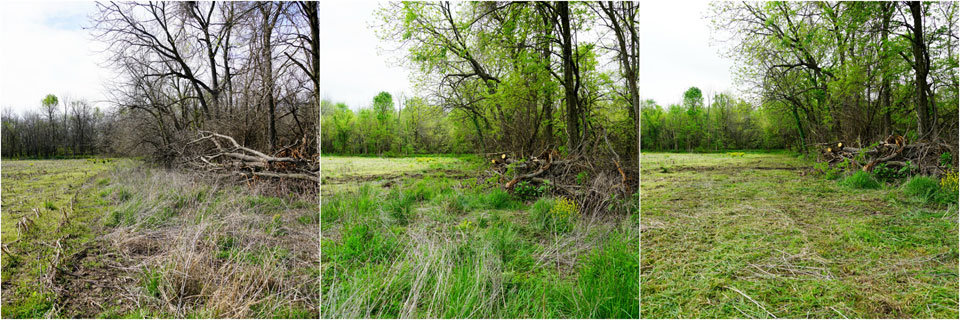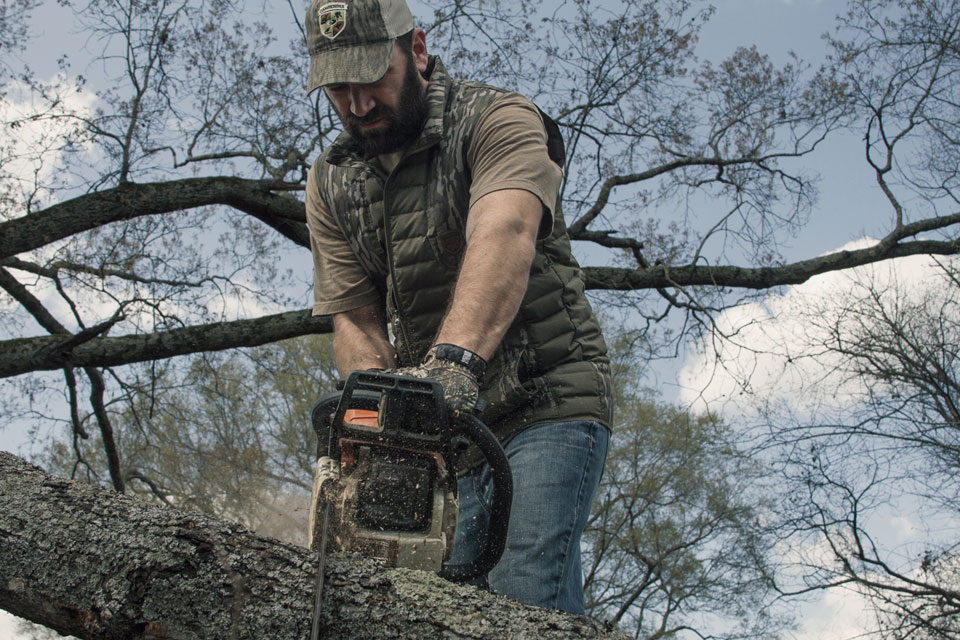
Those with large estates and expanses of wild growth must regularly care for their field tools to preserve their efficiency. Whether you are clearing an area for planting, habitat improvement, property line maintenance or simply for aesthetic reasons, all brush clearing tools must undergo careful and habitual upkeep. Cleaning, sharpening and otherwise maintaining your field tools increases their lifespan and ensures your safety while using them.
How to Care for and Sharpen Your Tools
Axe
Before sharpening your axe, clean and remove any rust from the blade. You can remove rust from an axe by submerging the blade in white vinegar for 24 to 48 hours. Using a steel sponge, gently buff away any residual rust on the blade and rinse it off with hot water. Dry the axe thoroughly and store it in a dry place.
To prevent an axe from rusting, keep the blade dry, clean and lubricated after each use. If you are in the field and need to lubricate an axe blade, gun oil, motor oil or beeswax can all help to prevent rust from forming. Make sure to remove any excess lubricant, oil or wax from the blade before storing it away.
When sharpening an axe at home, use a vise or clamp to safely hold it in place. In the field, you may either improvise a vise or very carefully hold the blade in your non-dominant hand so the edge is facing away from you. Support the axe handle on your shoulder or the ground. Run the sharpener or file across the edge of the blade, following the angle of the bevel.
Use the same number of strokes on each side of the blade to ensure an even and balanced edge. Sharpen each side until you’ve removed all the small nicks.

Machete
Machetes are the ideal tool for clearing brush and cutting thick branches. Their curved blade won’t get caught in dense growth. Regular maintenance for a machete blade includes cleaning after every use, oiling the blade to prevent rust and sharpening.
You may need to tailor your method depending on the blade material. Machete blades are typically carbon steel, stainless steel or high-carbon stainless steel. You can remove rust from a machete blade using sandpaper, WD-40 or a phosphoric acid-based rust remover.
To sharpen a dull machete blade, use a grinder, whetstone, Dremel or file. The choice of sharpener will depend on the current condition of the blade.
Use a grinding wheel if the blade is very damaged or has become very dull. The grinder will work very quickly and produce a lot of heat, so you may need to pour water on the blade at regular intervals to prevent it from warping.
A whetstone is a much slower but more controlled way to sharpen the edge of a machete. Soak the whetstone in water and place it in such a way that it will not move. Then, run the blade across the whetstone several times at a perpendicular angle.
To use a Dremel, secure the machete in a vise or clasp. Apply the Dremel to the machete edge laterally for the same length of time and with the same amount of pressure on each side of the blade. If you think the edges might not be even or the angle of the blade has become distorted, you can refine the edge with a whetstone or file.
To sharpen a machete with a file, hold your machete in a vise and run the file across each side of the blade in one direction. Alternatively, you can hold the file in the vise and run the machete across the file instead. Files are available in single-cut or double-cut varieties, but you can also get an intermediate variant that many consider to be the best for sharpening a machete.
How you take care of your machete’s handle depends on the material. You can treat a wooden handle with boiled linseed oil to help keep moisture out. Meanwhile, plastic handles simply need wiped down with a damp cloth.
Saw

Before you can sharpen your saw, make sure it’s in reasonably good condition. Always store your saw in a dry place to prevent it from accumulating rust. Lubricating the blade with oil, wax or WD-40 will help to prevent rust, and it will improve its cutting performance, too.
Like your other brush clearing tools, you should also take regular care of your saw’s handle. If it’s wooden, clean it with sandpaper to remove stains and caked-on debris before treating it with boiled linseed oil to help keep out moisture.
If you take good care of your saw blade, you may find it never rusts, but if it does, you can clean it off with a razor blade. Detach the handle and lay the saw blade down on your workbench. Holding the razor blade at a low angle, gently scrape the rust away from the saw blade.
Take off any residual rust with sandpaper, clean the blade with a dry cloth and apply a little oil or wax. Once your saw blade is clean and rust-free, you can sharpen it.
To sharpen your saw, get a small triangular or diamond-shaped file and work your way down the blade, sharpening each tooth bevel individually. The amount of time this takes will depend on the current condition of the blade.
Final words
Check the condition of your field tools regularly for cracks, nicks and other damage. If you need to perform an emergency repair in the field, remember to follow up with any additional maintenance as required when you return to your workshop.
When maintaining your brush clearing tools, always exercise caution and wear safety equipment such as protective goggles, gloves and work boots. Refrain from using damaged tools and purchase replacements instead.
When clearing your land, your safety should be your top priority. If you are unsure about maintaining your tools or don’t feel comfortable doing it yourself, seek the assistance of a local professional.



























